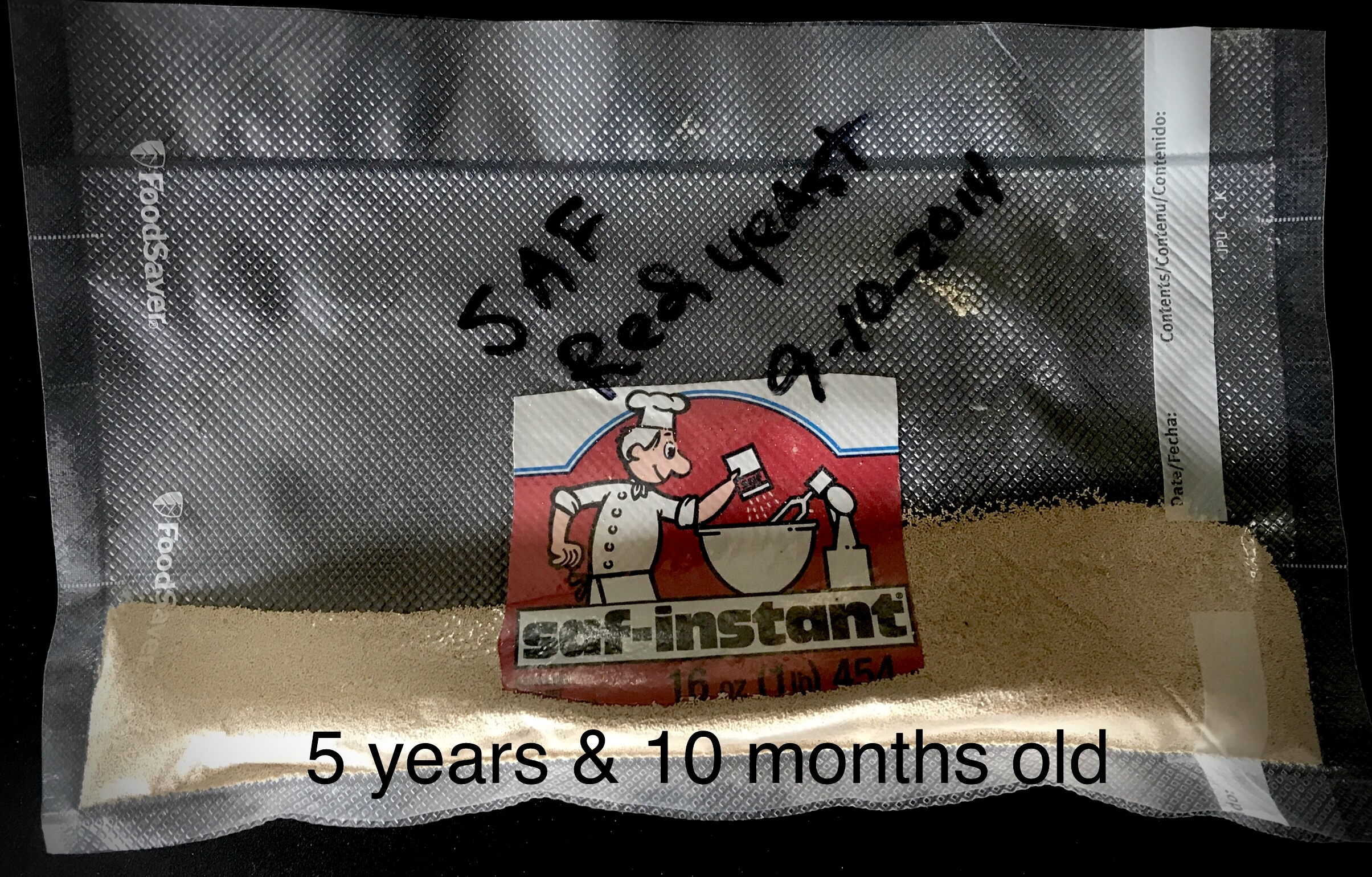
Commercial Yeast
- Storage
- How long does it last
- Testing for viability
- Bulk Purchasing is economical
- Temperatures for Commercial Yeast
1. Storage
The image above shows bulk SAF Red Yeast that is stored in the freezer in a vacuum sealed bag. A small amount is removed from the original supply and is stored in the freezer in a ZipLok bag for easy access. The yeast has lost some strength, but it is 2 months shy of 6 years old.
2. How long does it last
Stored properly, yeast is good for many years past the expiration date. Testing your expired yeast is a good idea. Checkout the “Update” at the bottom of this post.
3. Testing for viability
According to the Red Star Yeast (Lasaffre) website -
Follow these steps if you are unsure of the freshness of your yeast (or just want to give it a ‘good start’).
To ‘proof’ or test dry yeast, use the steps here: (if proofing fresh cake yeast scroll down.)
- Using a one-cup liquid measuring cup, dissolve 1 teaspoon of granulated sugar in 1/2 cup warm tap water at 110°F-115°F.
- Using a thermometer is the most accurate way to determine the correct liquid temperature. Any thermometer will work as long as it measures temperatures between 75°F and 130°F.
- If you don’t have a thermometer, the tap water should be warm but NOT hot to the touch.
- Stir in one 1/4 oz. packet (7g) or 2 1/4 tsp of dry yeast until there are no more dry yeast granules on top. Yeast should be at room temperature before using.
- In three to four minutes, the yeast will have absorbed enough liquid to activate and start to rise.
- After ten minutes, the foamy yeast mixture should have risen to the 1-cup mark and have a rounded top. It should look like the picture below.
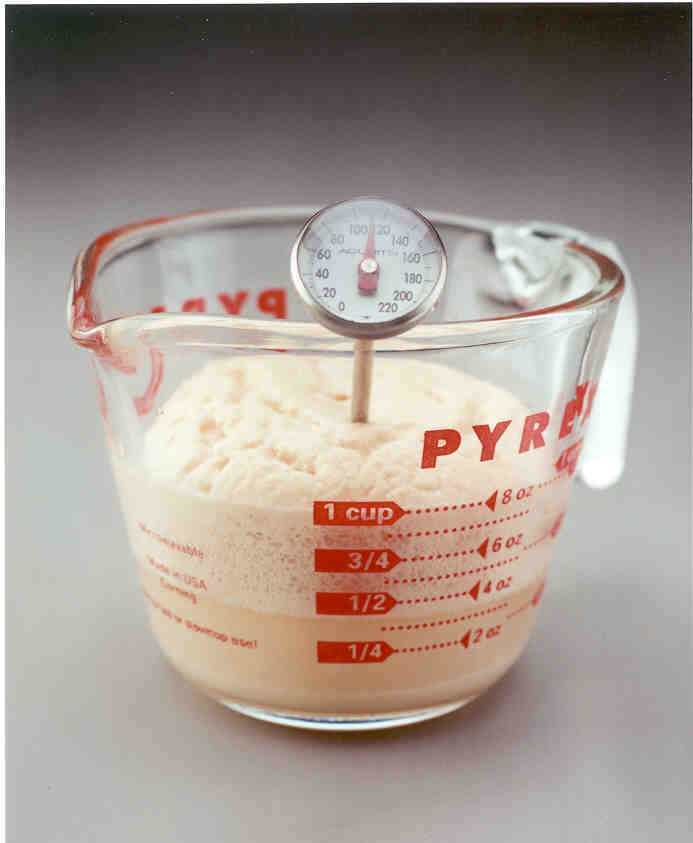
- If this is true, your yeast is very active and should be used in your recipe immediately.
- Remember to deduct 1/2 cup liquid from the recipe to adjust for the water used in this test.
- If the yeast did not rise to the 1-cup mark, your yeast has little or no activity. Discard this yeast.
4. Bulk purchasing (1 pound) is economical
Compare THIS PRICE to the small packs available at the local grocery.
By-the-way - many artisan bakers choose SAF Red. It is an Instant Dry Yeast and requires no proofing. It can also be mixed dry into the flour, which is convenient.
After almost 6 years it appears a new bag is in order. The old yeast is still raising the dough quite nice, but upon testing it fell a little short. And besides it’s so inexpensive.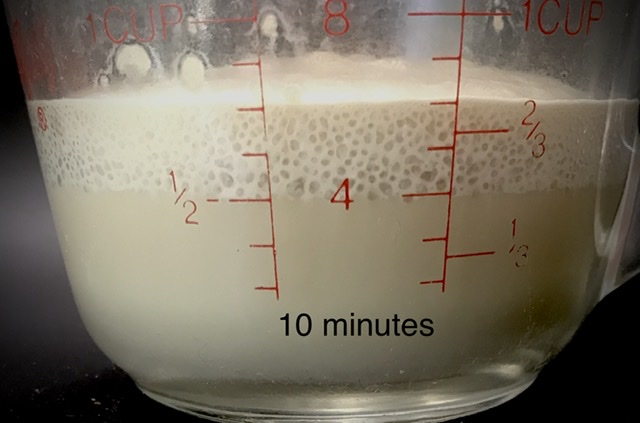
5. Temperatures for Commercial Yeast
The article on Bob’s Red Mill site is thorough and very informative.
*** begin Bob’s Red Mill ***
Rough Temperature Recommendations
The guide below will give you a rough idea of ideal water temperatures for proving your yeast.
- Water at -4°F means your yeast will be unable to ferment.
- Water at 68° to 104°F means that your yeast’s ability to grow will be hindered, and its growth rate will be reduced.
- Water at 68° to 81°F are probably the most favorable range for the yeast to grow and multiply in.
- Water at 79°F are considered the optimum temperature for achieving yeast multiplication.
- Water at 81° to 100°F is the optimum temperature range for the fermentation process.
- Water at 95°F is the fermentation temperature that yields the best result.
- Water at 140°F or higher is the kill zone for yeast. At temps like this or higher, you will have no viable live yeast left.
Of course, these tentative estimations can be higher or lower depending on the type of yeast you are using, and whether it is active dry yeast, live yeast, or rapid rise yeast. The bottom line is that yeast thrives in warm water, sleep in cold water, and die in hot water. So, like Goldilocks and the Three Bears, it’s important to get the temperatures “just right” for your yeast to thrive and your bread to obtain the best rise and flavors possible.
*** end Bob’s Red Mill ***
Update - the new yeast arrived and a test was run.
Even though your expired yeast is raising your dough, it may be less effective than a fresher batch. If you pay attention to fermentation timing, you may be ending your bulk ferment prematurely.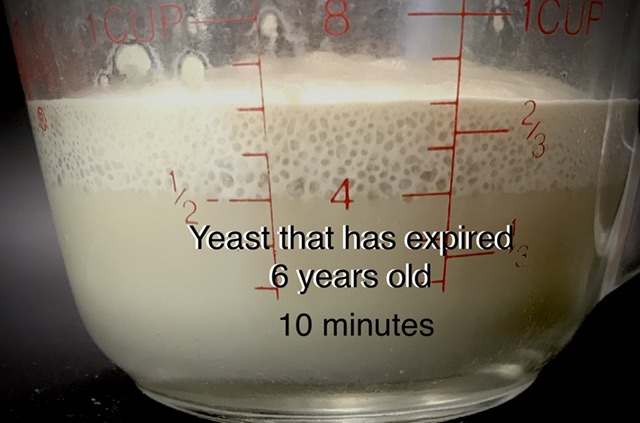
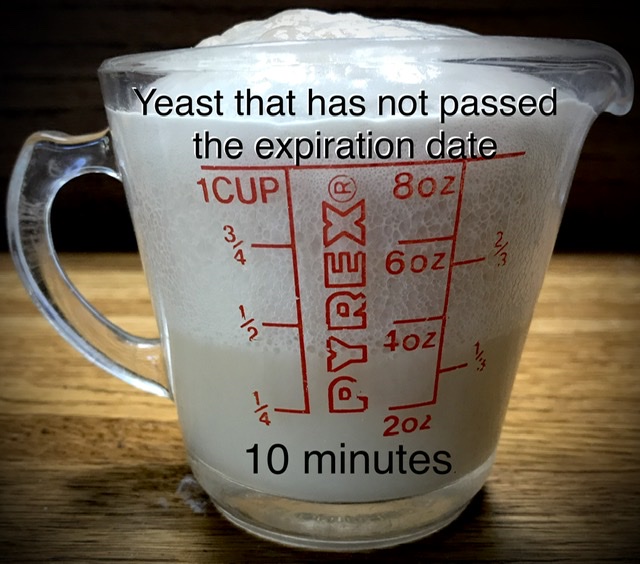
For those that are calorie conscious and want to use No Calorie Baking Sweeteners, THIS LINK should be informative.
Danny
I have a 2 lb bag (or what started as 2 lb bag) of Red Star at the bottom of my freezer, double freezer zip locked. I take out only about a 1/4 cup at a time into a small container when i need to refill. It's still good and strong after 10 years.
Ciabatta, I thought exactly like you.
But after testing my yeast for activity, it was discovered that the yeast I had been using for almost 6 years was not as strong as it was when it was fresh. At ~$8/pound, I thought it best to re-stock. I can say that the old yeast did a good job raising the bread, but I wanted a great job. I reason that when using the prescribed percentage of CY, I was not getting the fermentation results as the author. Notice the bottom image in the original post. It should have risen to 1 cup in the allotted time.
Danny
Can I get the water temp and feed type/amount to run the same test on mine?
edit. Sorry. Just reread the post. You put the parameters in there already. Will test mine later today. Thanks
Even though my old yeast raised the dough well, the test revealed it was performing at an estimated 50% deficit. Even though a faster rise is not something I seek, hopefully the crumb will be better and the oven spring greater.
Haven’t baked with it yet, but plan to bake up some baguettes tomorrow.
Danny
Ok Turns out, it’s not quite 10 years old. 8+ years at the bottom of the freezer.
1/2 cup 115F water
1 tsp white sugar
2 1/4 tsp aged Red Star dry active yeast (* might have been 2 1/2)
ambient temp 78F
5 mins in passes 1cup mark
10 mins:
Not sure if I missed anything in doing the test. I think this one still good. I guess if you have old or expired yeast. Be sure to test it for potency.
That yeast is a beast!
I use SAF Red (Lesaffre). And the bulk portion, like you, is vacuum sealed and kept in the freezer. I wonder if your brand makes a difference. I use Instant Dry Yeast and you are using Active Dry Yeast, but that shouldn’t make that much of a difference. Mine was weighed and I think it came out to 6.38 grams. Mine was definitely weak.
It seems that various commercial yeast vary in their potency.
Great test, thanks for posting...
Danny
Here is an interesting tid-bit that seems to contradict our results. “ Active dry yeast and instant yeast can generally be used interchangeably, one-for-one (although active dry yeast may be slower to rise). So if a recipe calls for instant yeast and you use active dry yeast instead, you may want to consider adding an extra 10 to 15 minutes for the rise time. If a recipe calls for active dry and instant is used, reduce the rise time by 10 to 15 minutes. Other than that the recipe can stay exactly the same and there is no need to make any changes.“
I wonder if the different coatings on IDY an SDY account for some of the different results and longevity?
Reinhart says that one should use 25% more yeast if using active dry vs instant dry yeast because the process that produces active dry about 25% of the yeast dies.
Boy Benny, the test don’t seem to confirm that, does it?
No it doesn’t at all. What we don’t know is whether either IDY vs ADY tolerates prolonged storage in a freezer better than the other. And of course we don’t know how the different brands compare to start off with, g per g there may be differing amount of yeast in each despite the weights being the same.
Are you sure this isn't that elephant toothpaste science experiment ?
Well I used to purchase fleishman yeast in jar and just use it out thr fridge till it depleted and never proofed it and never had an issue. Now I will just get the little sachets and use them withing a few weeks and again never have an issue. Fresh yeast on the other hand is much more sensitive but like the test above it can be used well beyond the recommended time limits (generally a few weeks refrisgerated). It can be frozen for months and sometimes I've noticed that using fresh that had has been frozen for a month or two seems to have an extra kick. Very counter-intuitive. Also somewhere on here is a post I made a few years ago of a science experiment I did with my then middle-schooler on yeast and sugar concentrations. I'll try and find it and post on this thread (flasks, equations etc the whole 9 yards)
http://www.thefreshloaf.com/node/55354/too-much-sugar-starves-yeast-junior-high-sci-project-find-out
Tried to find it the other week but couldn't - nice find !
This test was conducted on 06/29/2020, using yeast that expired 11/2019. First photo is after ten minutes, the second after twenty.
Image
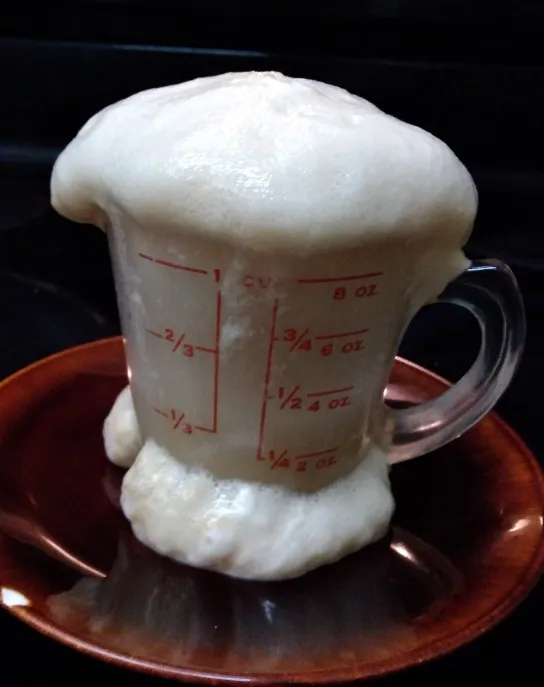
Image
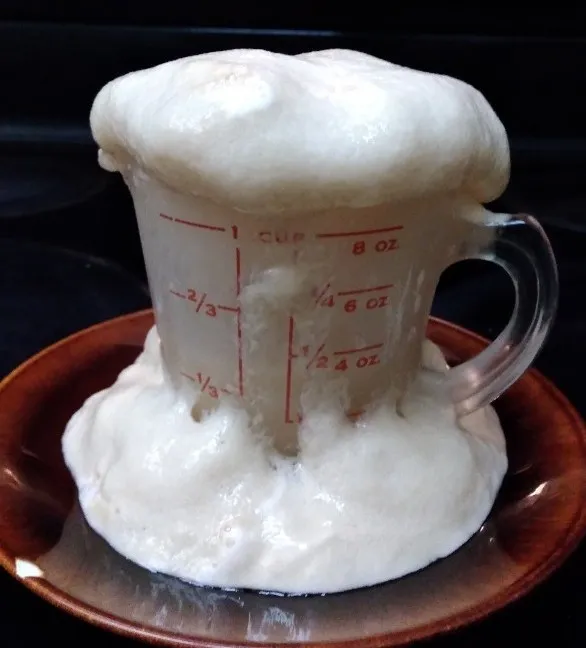
Wlaut, was your test run according to the instructions above?
After looking at Ciabatta and your result, I am wondering if Instant Dry Yeast and Active Dry Yeast test proof differently.
Beautiful images!
1/2 cup Spring Water @ 110F
2-1/4 tsp yeast.
1 tsp sugar.
Yeast was stored in my freezer from moment I received it until I used it.
From the looks of the Active Dry Yeast test, it seems that it may proof up differently than Instant Dry Yeast. Hopefully other bakers will also run the test and post images to confirm or reject the idea.